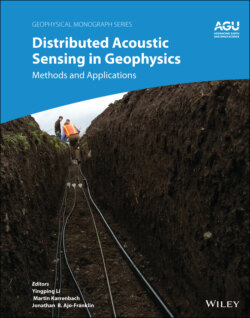Читать книгу Distributed Acoustic Sensing in Geophysics - Группа авторов - Страница 60
3.2.3. Fabrication and Performance Test of DMOF
ОглавлениеThe microstructured optical fiber is fabricated by a continuous online UV‐inscription system, which consists of a fiber winding module, UV laser source, laser collimation module, and computer control unit; see Figure 3.4 for details. The fiber winding system is based on the reel‐to‐reel process of fiber with large winding velocity control (from 1 mm/min to 10 m/min) and uniform stress control (from 0 to 100 N). The fiber used during the fabrication process is coated with a UV transparent silicone layer, which allows the microstructure fabrication process without removal of the fiber coating. The laser system we used was a conventional 248 nm pulsed excimer laser with a maximum pulse energy of 300 mJ and a large beam size of 26 mm × 12 mm, which can ensure highly effective UV exposure in the fiber core with only a single pulse of radiation, and acceptable fiber vibration during the winding process. Moreover, scattering intensity of the microstructure point over a large range of intensities could be controlled by the UV pulse energy. Finally, a microstructure with arbitrarily spatial distribution along the fiber could be designed by a computer control unit. The scattering intensity of each microstructure can be monitored by an OTDR system with an ultrashort pulsed tunable laser.
Figure 3.3 Simulated intensity distribution along fiber when the intensity of the backscattering light from the microstructure is, respectively, enhanced by (a) 0 dB, (b) 3 dB, (c) 7 dB, and (d) 10 dB higher than that from standard SMF.
Figure 3.4 The block diagram of the continuous online DMOF fabrication system.
To test the optical characteristics of the DMOF, the light of an amplified spontaneous emission (ASE) source is injected into the fiber. The spectra of backscattering light in the SMF and DMOF are, respectively, observed through an optical spectrum analyzer and illustrated in Figure 3.5a. It is clear that the spectrum of backscattering light from the DMOF is colorless across the C band (1525–1656 nm), and its intensity has been improved by more than 10 dB from that of the SMF. Since the microstructures are weakly reflective and just located at local points, the total insertion loss is as low as to be neglected. Moreover, the intensity stability at certain points in the fiber without and with microstructures is, respectively, monitored during 100 s and presented in Figures 3.5b and 3.5c. Compared with the random fluctuation of the intensity distribution in the SMF, the DMOF keeps a much higher SNR and stability, both in spatial and time domains, which are in consistent with the simulation results.
Figure 3.5 Comparison between the DMOF and the SMF: (a) Spectra of the backscattering light in the SMF and DMOF; the 100 s intensity distribution records of a 10‐m‐long section of SMF (b) and DMOF (c).
